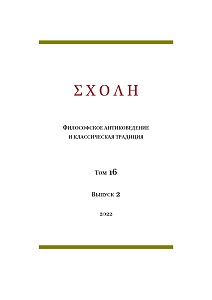“Иное” в третьей гипотезе “Парменида” (Prm.158d3-6)
“Other” in the Third Hypothesis of “Parmenides" (Prm. 158d3–6)
Author(s): Irina ProtopopovaSubject(s): Metaphysics, Ancient Philosphy, Ontology
Published by: Новосибирский государственный университет
Keywords: Plato; the “Parmenides”; third hypothesis; “one”; “other”; immensity;
Summary/Abstract: The main purpose of the paper is to comment on Prm. 158d3-6. Consideration of this passage is preceded by a brief overview of various approaches to “Parmenides”. The most important difference in the approaches is determined by the attitude of the researchers to the “subject” of the eight hypotheses. F. Cornford believes that “one” and “is” in Plato’s text are not unambiguous, therefore the “subjects” of hypotheses are different, and, consequently, the conclusions from these hypotheses, although different, are not contradictory. Cornford’s approach is productively developed by K. Sayre and R. Turnbull. The author’s interpretation of the “Parmenides” is based on the same premise of the ambiguity of “one” and “is”. Other researchers (R. Allen, S. Rickless, M. Tabak) disagree with this, insisting that the “subject” in all hypotheses is the same, so the conclusions of different hypotheses are contradictory, and the conclusion from the most extensive, the second hypothesis, is obviously absurd (Allen). Tabak’s point of view is particularly abrupt, assuming that Plato’s goal in the second part is a parody of the views of the Eleatics and Sophists, often presented with deliberately incorrect and absurd conclusions. Tabak believes that only the third hypothesis applies to the views of Plato himself. It is with that one that the second part of the paper is dealing, analyzig the sense of “other” in Prm. 158d3–6. The author consider what is the meaning of “nature other than eidos” in the context of the ideas of the “receptacle” and χώρa in the “Timaeus” (50d, 51a7–b1), and what is the “idea of the immensity” in the context of the reasoning about the one, many and immensity in the “Philebus” (16de). Another comment concerns the meaning of ἕτερόν τι ἐν ἑαυτοῖς γίγνεσθαι and compares several translations of this passage (Cornford, A. Hermann, S. Scolnicov, Sayre, Tabak). In conclusion, the author offers her own interpretation of “other” in connection with the seventh hypothesis of the “Parmenides”.
Journal: ΣΧΟΛΗ. Философское антиковедение и классическая традиция
- Issue Year: XVI/2022
- Issue No: 2
- Page Range: 783-790
- Page Count: 8
- Language: Russian

